| Research base of carbon vehicles |
The Institute for Automotive and Manufacturing Advanced Practice (AMAP)
is a part of the Faculty of Applied Sciences within the University of Sunderland.
AMAP purchased a UC-win/Road license and an iDrive Driving Simulator for
research into Electric Vehicles and LCV (Low Carbon Vehicles) as well as
for a range of human factors research (HMI).
Over recent years the University and AMAP have established a centre of
excellence at Sunderland in Low Carbon Vehicle (LCV) technology and their
staff are active in a wide range of R & D projects involving, for example;
electric vehicles, hybrid electric vehicle technology, fuel cells, advanced
manufacturing in the LCV industry, lightweight materials, vehicle safety
and crashworthiness.
Sunderland University's plans for the future involve building on the strong
platform they have developed for further strengthening the research into
Low Carbon Vehicle Technology. |
 |
|
Prof. David Crolla, AMAP |
| Utilization of eco-drive plug-in |
The University is continuing to develop in the delivery of projects across
the automotive, manufacturing and maintenance sectors, and they intend
to work with regional industries to reinforce Sunderland as the leading
UK Centre of Excellence for LCV Technology.
HMI (Human Machine Interaction) Research at Sunderland utilizes the state
of the art FORUM8 driving simulator to conduct LCV simulations investigating
user experience requirements and enhancements for LCVs, contributing to
the user acceptability agenda.
The driving simulator using the UC-win/Road software along with the `EcoDrive'
plug-in, combined with eye tracking and other HMI methodologies provides
an ideal test-bed to safely research various information systems, providing
vehicle designers/manufacturers with knowledge on how people use their
vehicles.
Driving simulators are commonly used as part of driver training, particularly
by large fleet operators of vans and trucks. Sunderland University and
AMAP are also working with driving schools and other key road safety practitioners
with a view to developing a driver education program for LCV users in appropriate
and safe use of their vehicle.
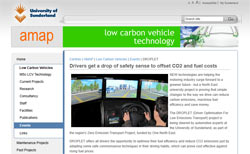 |
|
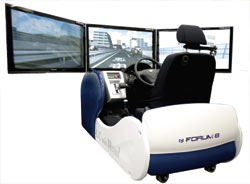 |
Research project with UC-win/Road
-introduced in AMAP's website |
|
iDrive type of DS |
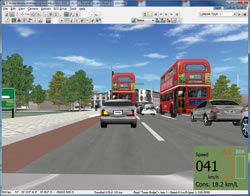 |
|
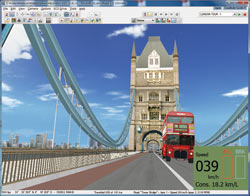 |
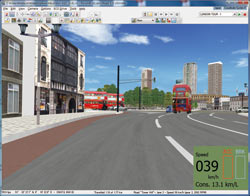 |
|
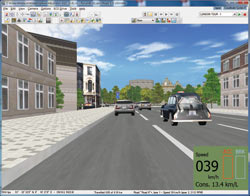 |
| VR model (London) created with Eco-drive plugin by AMAP and used for their
research |
| Comparison test using simulator |
Professor David Crolla of AMAP explained; "There is already a vast
range of Low Carbon Vehicles (LCVs) available in prototype and commercial
forms. They include many different technological solutions: mild hybrid,
full hybrid, petrol-electric, diesel-electric, plug-in electric, range-extender
electric etc. Also, they include most vehicle applications: commuter cars,
passenger cars, vans, light trucks, buses, and small utility vehicles.
The key performance incentives behind these vehicles are reduced energy
usage and reduced carbon-based emissions. And the main method used to assess
vehicle performance and compare it with current IC engine based vehicles
is to 'drive' the vehicle over one of the globally agreed driving cycles.
In fact, these tests actually take place under controlled laboratory conditions
on a rolling road dynamometer.
Although such tests inevitably arouse considerable controversy, they are
nevertheless accepted by the industry as a fair, controlled method of comparison.
Nevertheless, the results bear little resemblance to real world practical
driving.
Therefore this research project has the overall aim of comparing the real
world performance of LCVs using a state of the art driving simulator from
Forum8. Our aim is to:
1. Develop mathematical models of different LCVs
2. Integrate these models into the Forum8 driving simulator software UC-win/Road
3. Conduct simulator-based studies using typical driver groups to compare
the performance of competing vehicles in terms of economy and emissions
4. Develop a unique simulator-based test bed for the LCV industry to conduct
laboratory testing on prototype LCV designs
The research challenge is to include sufficient detail of the components
- engines, motors, batteries, power electronics, gearboxes etc - to capture
realistic predictions of the overall energy usage characteristics, but
without excessive mathematical complexity.
The outputs from these models which will run in real time will then be
integrated with the 3D VIS simulator software UC-win/Road. A verification
exercise of the modeling approach will be conducted using a well-known
vehicle example such as the Toyota Prius, whose performance properties
are well understood and accepted.
Laboratory based experiments using cohorts of typical drivers will then
be designed with the aim of comparing different LCV designs with equivalent
IC based engine vehicles over the same driving scenarios. The simulator
offers a unique facility for doing this under carefully controlled conditions
but still using inputs from real drivers in contrast to the nominal optimal
operating points selected for the current standard driving cycle tests." |